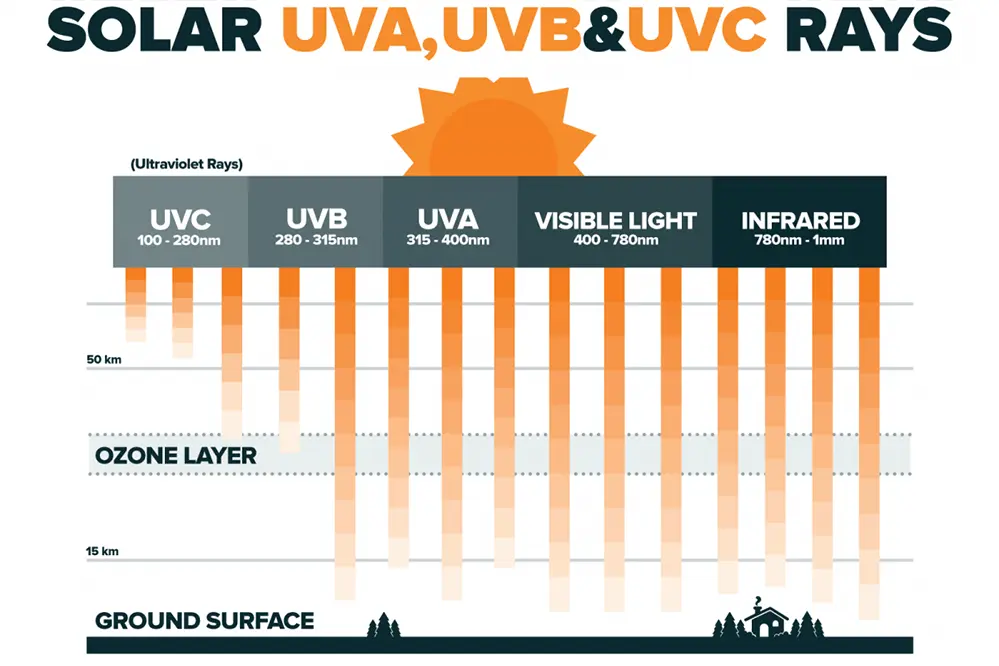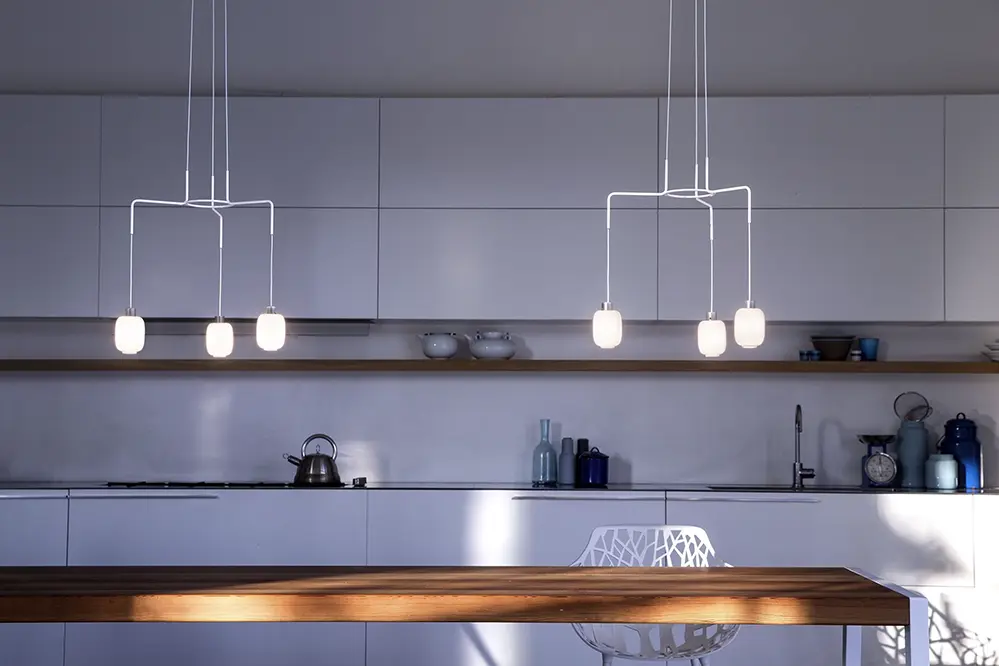Can RGB LED strip make white? This question challenges many enthusiasts and professionals alike, often leading to misconceptions about the capabilities of RGB technology. Many assume that RGB strips are limited to vibrant colors, overlooking their potential to produce a clean, white light.
Understanding this potential is crucial, as it opens up a world of design flexibility and energy efficiency. The benefits of mastering this technique are profound, offering enhanced ambiance and functionality in various settings.
In this article, we will unravel the science behind RGB LED strips, explore their applications, and provide practical tips for achieving the perfect white light. Embark on this enlightening journey to discover how RGB technology can transform your lighting experience.
Understanding RGB LED Strips
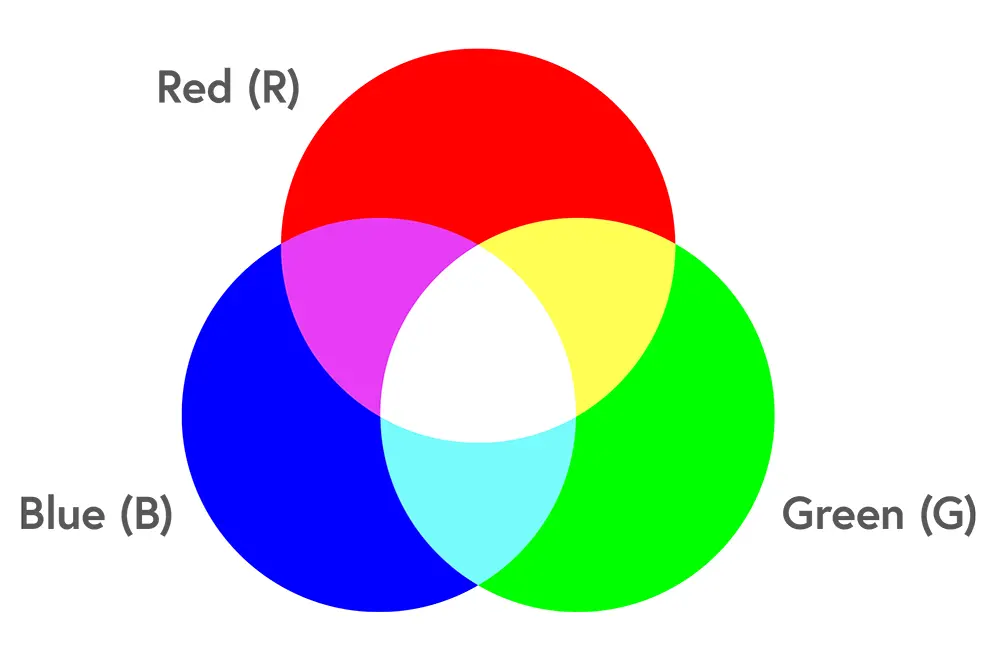
RGB LED strips, a marvel of modern lighting technology, utilize red, green, and blue diodes to produce a myriad of colors. By intelligently adjusting the intensity and luminosity of each diode, these versatile strips can create an almost infinite spectrum of colors.
These sophisticated strips shine in their ability to transform environments through vibrant hues. The potential to alter mood and ambiance with the touch of a button is unparalleled.
Significantly, understanding the technology that powers RGB LED strips is crucial for maximizing their capabilities. From signage to sophisticated interior decor, their impact is far-reaching.
Equally impressive is the RGB strip’s adaptability to various settings. They can be used in residential, commercial, and even industrial contexts, providing extraordinary illumination solutions.
Inspiring creative applications, RGB LED strips open avenues for innovative lighting design. They cater to the imagination, enabling individuals and businesses alike to express their unique visions through light.
Ultimately, the journey of mastering these strips is about more than just lighting spaces. This illuminating venture promises to light the path to endless possibilities, redefining how we harness color and light in our everyday lives.
How RGB LED Strips Produce Color
RGB LED strips amaze with their color-producing magic.
These versatile strips utilize red, green, and blue diodes. By adjusting the intensity of each diode, they can produce a wide spectrum of colors. This characteristic makes them perfect for crafting environments with soothing pastels or vibrant brights. Consequently, leveraging the balance of these three primary colors allows users to create the ideal ambience tailored to their preferences.
The marriage of technology and creativity fuels the vibrancy.
The blend of colors draws on years of scientific innovation – an exciting reality that today’s lighting enthusiasts can tap into. By modulating light, designers craft eye-catching effects that captivate viewers.
Their vast color potentials encourage endless possibilities in artistic lighting design, opening doors for new experiences. Exciting developments continue as more advanced technologies incorporate RGB LED strips, promising that the future will be as bright as these wondrous lights.
Can RGB LED Strip Make White Effectively?
Indeed, RGB LED strips are capable of creating white light by harmoniously mixing the intensities of the red, green, and blue diodes. This blend can achieve a satisfactory white that suits many decorative and ambient lighting needs, allowing for a versatile lighting solution.
To enhance the precision of the white light, some strips include a “fourth diode.” This is often a specific white LED, providing added accuracy in color representation. As such, the evolution of RGBW (Red, Green, Blue, White) strips marks a new chapter where the fusion of flexibility and precision ensures that these innovations remain at the forefront of modern lighting design.
Mixing Red, Green, and Blue
By combining red, green, and blue—fundamental components—RGB LED strips achieve white light excellence.
Mixing red, green, and blue at full intensity allows for the creation of pure white light.
In RGB LED strips, the fusion of red, green, and blue light is a remarkable process. When each color is set to full brightness, they collectively produce a radiant white light, effectively mimicking natural daylight.
The precision with which these colors blend speaks to incredible advancements in technology, allowing these LED strips to cater to even the most demanding lighting atmospheres, offering both utility and aesthetic appeal.
Comparing with Dedicated White LEDs
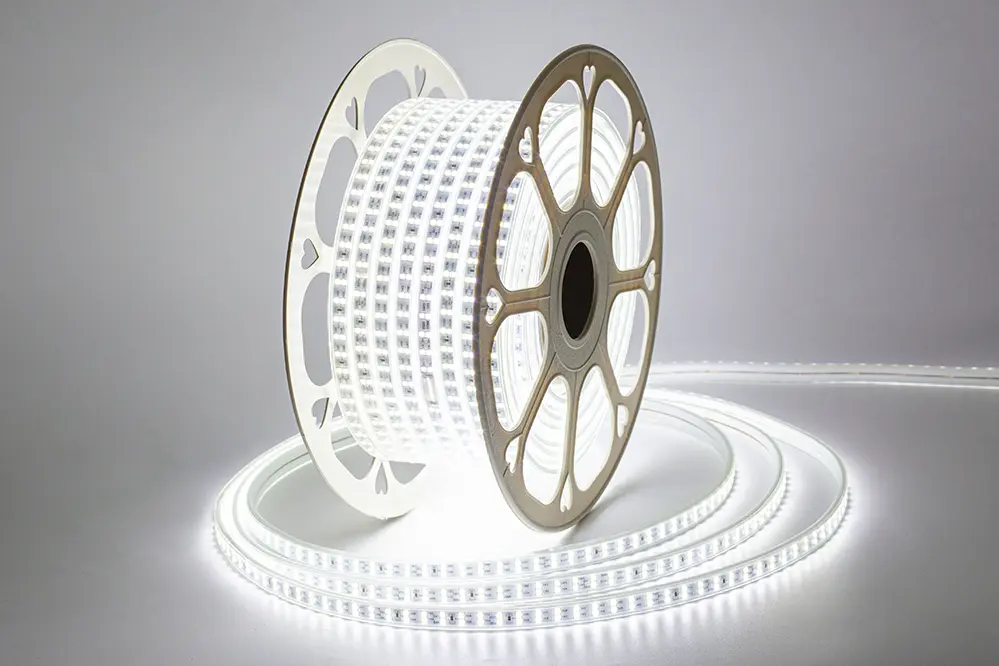
A dedicated white LED strip remains the unrivaled champion of authentic white light, consistently offering a singular wavelength that resonates with purity and clarity, unmatched by its RGB counterparts.
Despite RGB LED strips’ innovative blending capabilities, they still fall short of achieving the same naturalness.
Generally, RGB LEDs conjure white by striking a balance between red, green, and blue (a phenomenon widely recognized as additive color mixing).
Despite this impressive feat of engineering, inherent variations in LED quality and divergences in calibration might occasionally lead to a slightly off-white hue.
These subtle differences in color accuracy could impact environments requiring specific white tones, highlighting the advantages of choosing dedicated white LEDs for projects demanding such fidelity.
Nevertheless, the beauty lies in choice: while RGB’s white may falter in consistency, its customization capabilities cater to broader creative visions. Embracing diversification signifies that every illumination choice remains a step towards a brightly innovative future.
Types of Whites in RGB LEDs
The art of producing white light using RGB LED strips involves synthesizing various white tones, each distinguished by its own unique characteristics. These tones span the spectrum from warm, inviting whites evoking comfort and nostalgia, to crisp, blue-tinged whites inspiring a sense of clarity and precision, all showcasing the versatile capacity of this lighting innovation.
Such diverse white variations offered by RGB LEDs not only accommodate specialized needs but also invigorate artistic projects and innovative installations with unparalleled dynamism.
Cool White vs Warm White
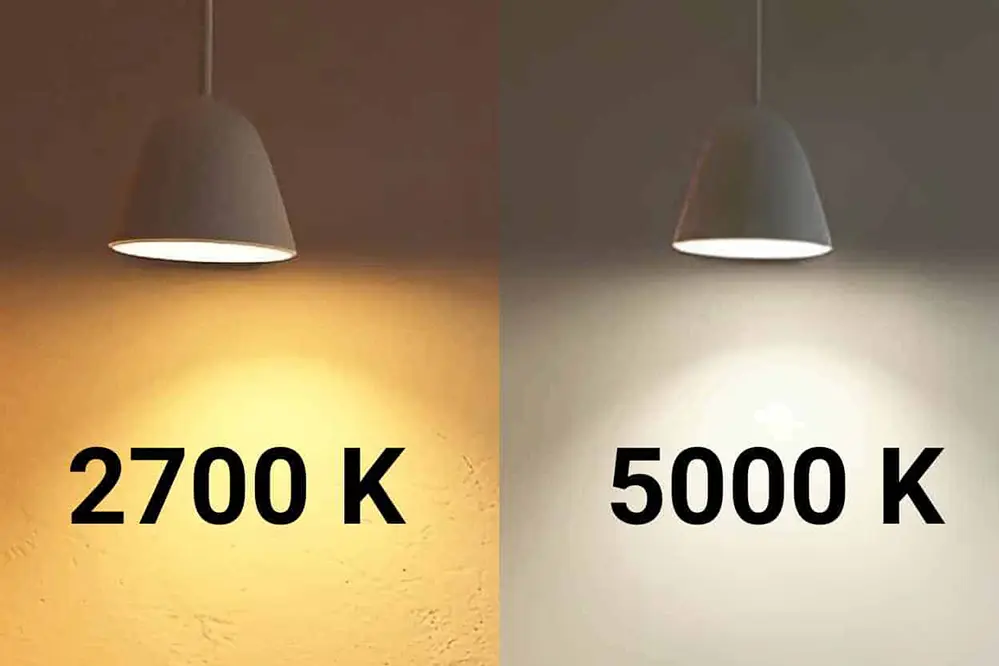
Choosing the right white.
Selecting between cool white and warm white depends on the desired ambiance. Cool white, with its blue undertones, presents an image of modernity and cleanliness, making it an excellent choice for task-oriented spaces. Conversely, warm white exudes a cozy glow that evokes comfort and relaxation.
The impact of lighting on spaces.
In applications where focus and alertness are paramount, like kitchens or offices, cool white provides an invigorating atmosphere. Meanwhile, in spaces meant for unwinding, such as living rooms or bedrooms, warm white creates a serene environment that encourages relaxation and warmth.
A world of possibilities awaits as we explore the immense potential of lighting transformations. As we transition into 2024, advances in LED technology will continue to refine the spectrum of light available to us. These innovations promise to enrich spaces with tailored ambiances, enhancing both aesthetic allure and functional brilliance in every environment.
Neutral White Option
Neutral white is a versatile lighting choice, providing balance, a middle ground on the color spectrum. It is frequently the preferred option for spaces requiring a natural daylight-like feel.
Offering approximately 4000K on the Kelvin scale, neutral white sits between warm and cool tones.
Industrially, neutral white light finds its utilization in retail and commercial settings, where (efficiency remains uncompromised) and productivity is paramount.
These spaces aim to enhance color accuracy in presentations of products and workplace environments, ensuring precise visual perceptions.
Neutral white fosters an energized yet comfortable ambiance, striking the perfect balance by supporting alertness without the starkness of cool white or the cozy warmth of yellow-white hues.
Ultimately, the choice for neutral white should not be overlooked. It guarantees a harmonious environment suitable for diverse activities across various spaces.
Adjusting White Color Temperature
Optimizing white on RGB LEDs is crucial.
The ability to fine-tune white color temperature is paramount in utilizing RGB LED strips to their fullest potential. This is not limited to achieving pure white but also extends to adjusting nuances of warmth or coolness, allowing you to tailor each setting precisely. Consequently, an RGB LED strip can make white, delivering dynamic adjustments to meet diverse preferences and enhance environments with tailored lighting experiences.
Achieving this involves balancing the RGB channels.
These RGB mixes achieve temperature settings, from the inviting warmth of 2700 Kelvin, mimicking incandescent lights, to the stark, cool ambience of 6500 Kelvin often associated with daylight. Customizing temperature in this way ensures the right mood and visual comfort.
Harnessing the potential of RGB LED strips not only augments interior lighting but signifies an advanced capability in creating personalized environments. As of now, this innovative technology in 2023 has reached new heights, with improved color rendition and sophisticated control systems enhancing white temperature adjustments for superior lighting precision.
Benefits of RGB LEDs Producing White
The versatility of RGB LEDs producing white light is profoundly transformative for both personal and professional spaces. It marks the advent of a new era where lighting adapts to our ever-changing needs, promising to create environments that enrich everyday experiences.
Recent years, advancements in LED technology dramatically enhanced RGB capabilities, enabling finer control over white light production. Today, we can create white light from RGB LED strips that rivals traditional lighting sources in both brightness and warmth. This adaptability allows for a seamless transition between different lighting conditions, whether in a cozy home or a bustling workspace.
Moreover, it’s not just about achieving a standard white; it’s the potential to modify shades of white according to mood and requirement. Each environment, whether a tranquil home office or a vibrant retail space, benefits from these customized lighting solutions that go beyond static illumination. Imagine the productivity boost and ambiance enhancement possible with such dynamic options at your fingertips.
Beyond the quality of the light produced, patrons of RGB LED technology enjoy a multitude of energy efficiencies. Consuming minimal power while delivering maximum impact, these strips lower operating costs and reduce carbon footprints. The pledge to sustainability is fortified through the enduring life of LEDs, minimizing waste and aligning with global green initiatives.
By integrating RGB LEDs into your lighting strategy, you unlock a world of vibrant illumination possibilities. It’s a harmonious blend of innovation and functionality that pushes the boundaries of what’s possible in modern lighting design.
Limitations of RGB LEDs for White
While RGB LED strips are celebrated for their versatility and vibrancy, achieving an immaculate white light comes with challenges. The inherent design of RGB LEDs poses potential limitations in producing perfect whites.
Creating white with RGB relies on the additive color process. Adjustments in the balance of red, green, and blue can only approximate white. The result is often slightly off-white hues or variations that may not satisfy all lighting standards and purposes without incorporating a white LED chip.
The fundamental issue stems from the diodes used in RGB LEDs, which are not inherently designed for white light. This restriction can affect settings where a pure, neutral white is critical, such as galleries or clinical environments, where accurate color rendition is indispensable. Addressing these requirements, manufacturers have begun innovating with alternative solutions like RGBW (Red, Green, Blue, White) strips, which include a dedicated white LED for precision.
Despite these challenges, advancements in technology continue to propel us toward solutions that overcome such limitations. The addition of a white diode specifically addresses the shortcomings of traditional RGB LEDs, providing a more polished and cleaner white output. This pivot empowers designers and users alike to reach new heights in crafting lighting experiences that are both functionally and aesthetically captivating. The evolution of lighting technology promises continual improvements and distinctions that enhance the allure of RGB LEDs and their applications.
Enhancing White Output with Controllers
Achieving the perfect white demands strategic settings and controls.
Controllers play a pivotal role in this quest. They enable precise modulation of each RGB channel, allowing for the exact compositions of colors, including white. By adjusting the intensity of the red, green, and blue diodes, users can approximate the white spectrum, albeit with varying degrees of success.
The key is in optimizing each channel’s output.
Sophisticated controllers utilize pulse-width modulation (PWM) techniques that adjust the cycles of current delivered to each diode. By doing so, they achieve a pseudo-white that can be surprisingly effective in various lighting applications—this functionality allows for a tailored approach.
In an age where customization meets precision, advanced smart controllers offer unparalleled versatility in setting up RGB LED strips to deliver the most desired lighting effects, bridging the gap between expectation and reality. As technology evolves towards the end of 2023, these innovations redefine how and where RGB LEDs can illuminate our lives with exceptional brilliance.
Selecting the Right RGB LED Strip for White
Choosing the ideal RGB LED strip is essential.
The endeavor to create white with RGB LED strips begins with selecting products that offer superior color blending capabilities. Look for strips that allow fine-tuning across the red, green, and blue spectrums, enabling a more precise approximation of white. Additionally, ensure the strip is compatible with advanced controllers to fully explore the potentials of dynamic lighting.
Consider the RGB LED strip’s color fidelity.
Color Rendering Index (CRI) ratings indicate how accurately a light source reveals the true colors of objects compared to natural light. High CRI ratings mean better whites and more vibrant overall lighting, making it crucial to opt for strips with a high CRI.
Your investment in quality RGB LED strips will not only yield a more authentic white light but will also unlock a myriad of vibrant lighting options. As we stand on the precipice of technological innovation at the end of 2023, embracing these cutting-edge advancements can dramatically enhance spaces with both elegance and efficiency. Leveraging these insights, you can transform any environment with superior light quality, echoing the brilliance of tomorrow today.
Common Applications for White RGB LEDs
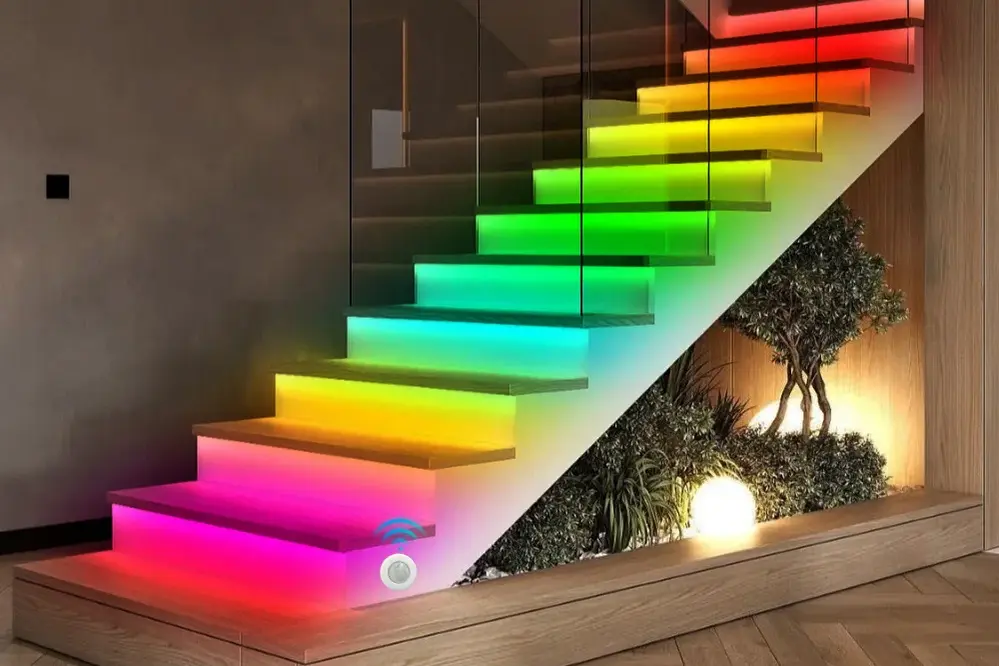
White RGB LEDs illuminate myriad modern settings, seamlessly blending utility with aesthetic appeal. Their versatility has made them indispensable in both residential and commercial domains.
In contemporary homes, white RGB LEDs are the cornerstone of sophisticated lighting schemes, highlighting architectural features or setting the mood with adjustable brightness and color. Their ability to transform a space almost instantaneously is truly remarkable.
Retail spaces leverage the adaptive nature of white RGB LEDs to enhance product displays, creating a captivating and inviting ambiance. This dynamic lighting can contribute significantly to the consumer’s shopping experience, potentially influencing purchasing behavior.
In offices, these LEDs provide not only functional lighting but also the versatility to modify the workspace atmosphere. Different lighting settings, from crisp white for focused work to warmer tones for relaxation, can boost employee productivity and well-being.
From enhancing exhibits in museums to creating immersive atmospheres in restaurants, white RGB LEDs shine brilliantly. Their application spans numerous settings, highlighting the intersection of innovation and inspiration.
Troubleshooting Issues with White RGB LEDs
Achieving a perfect white with an RGB LED strip requires precision, attention, and a keen understanding of the nuances that different colors bring together. When striking the right balance, RGB strips can illuminate your space with a stunning white brilliance.
Identifying discrepancies often starts with reviewing the basic installation guidelines provided.
Commonly, when the desired pure white isn’t achieved, calibration issues (misaligned individual color intensities) are evident.
These variances can be adjusted by recalibrating or replacing faulty components, ensuring each diode is functioning optimally.
Another area of potential difficulty lies in inconsistent power supply or improper voltage compatibility, which causes LEDs to emit incorrect hues. Addressing these challenges through the use of an appropriate power adapter can rectify the inconsistencies and bring out the true potential of your RGB strips.
Finally, the use of a high-quality LED controller is paramount. Ensure compatibility and accuracy for troubleshooting less intuitive problems, transforming interruptions into radiant solutions.
Conclusion
RGB LED strips offer the remarkable ability to produce a vibrant white light by precisely calibrating the intensities of their red, green, and blue diodes. This capability not only meets but often exceeds expectations when each component is correctly configured and maintained. Although challenges such as installation complexities or power supply inconsistencies may arise, they are typically manageable with informed solutions. This adaptability underscores the potential of RGB LED technology to transform lighting environments, providing both aesthetic appeal and functional brilliance.
The process of achieving white light with RGB LED strips exemplifies the harmonious blend of art and science in modern lighting technology. As you master this technique, you illuminate your space while gaining a deeper understanding of the intricate dynamics of colored light combinations. This journey is a testament to the transformative power of contemporary lighting solutions, inspiring creativity and precision in every project. By trusting in the resilience of technology and maintaining vigilant upkeep, you can witness your surroundings evolve into spaces of serene and harmonious brilliance, reinforcing the connection between intention and outcome.

